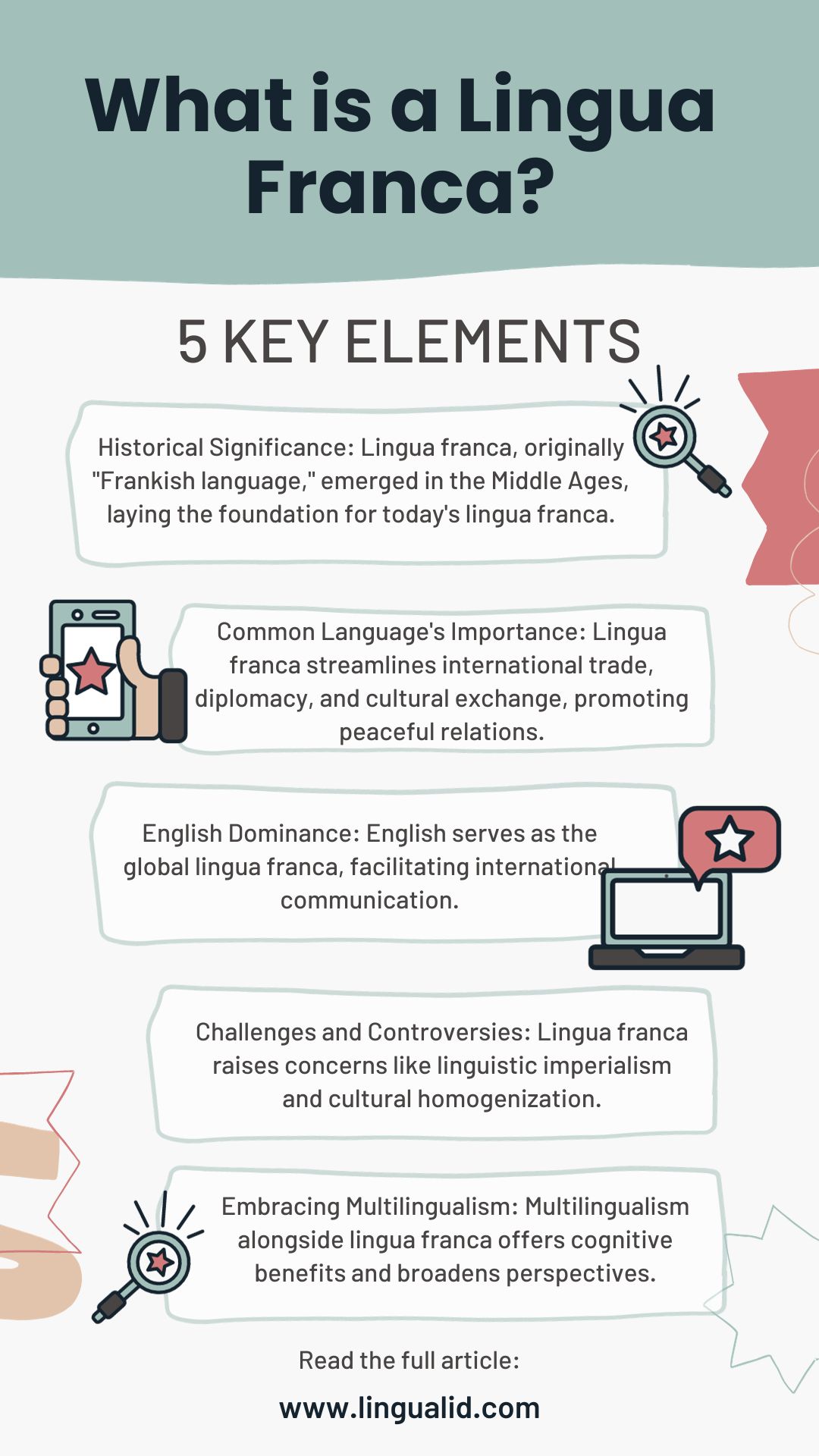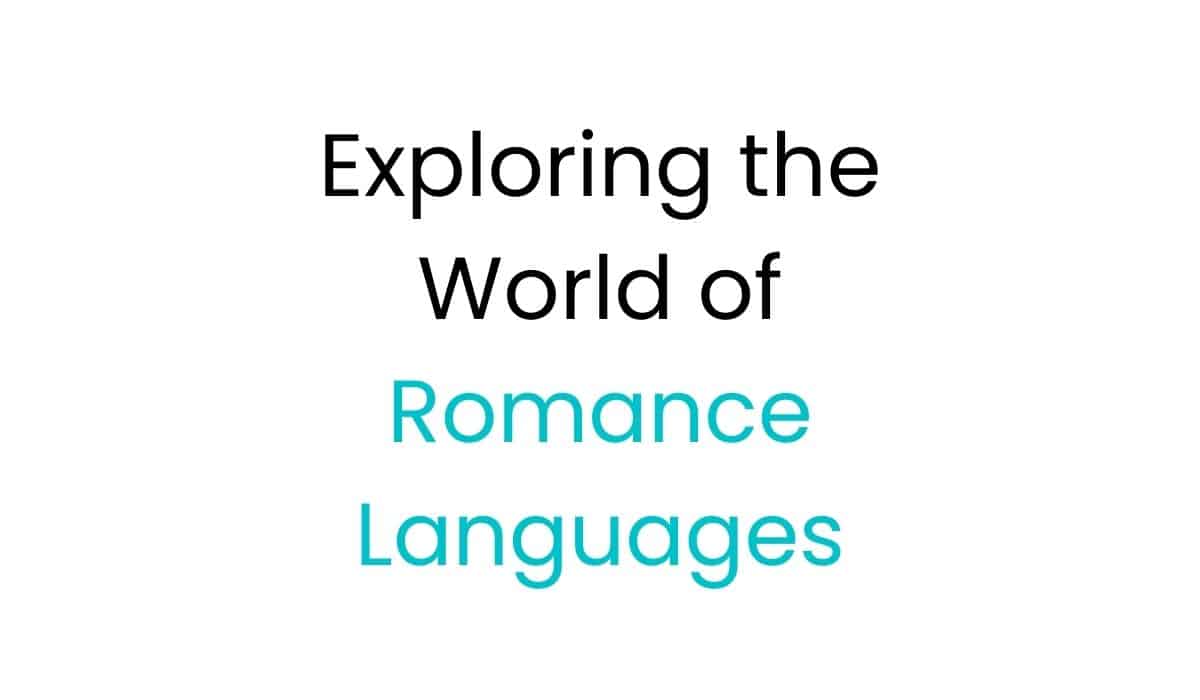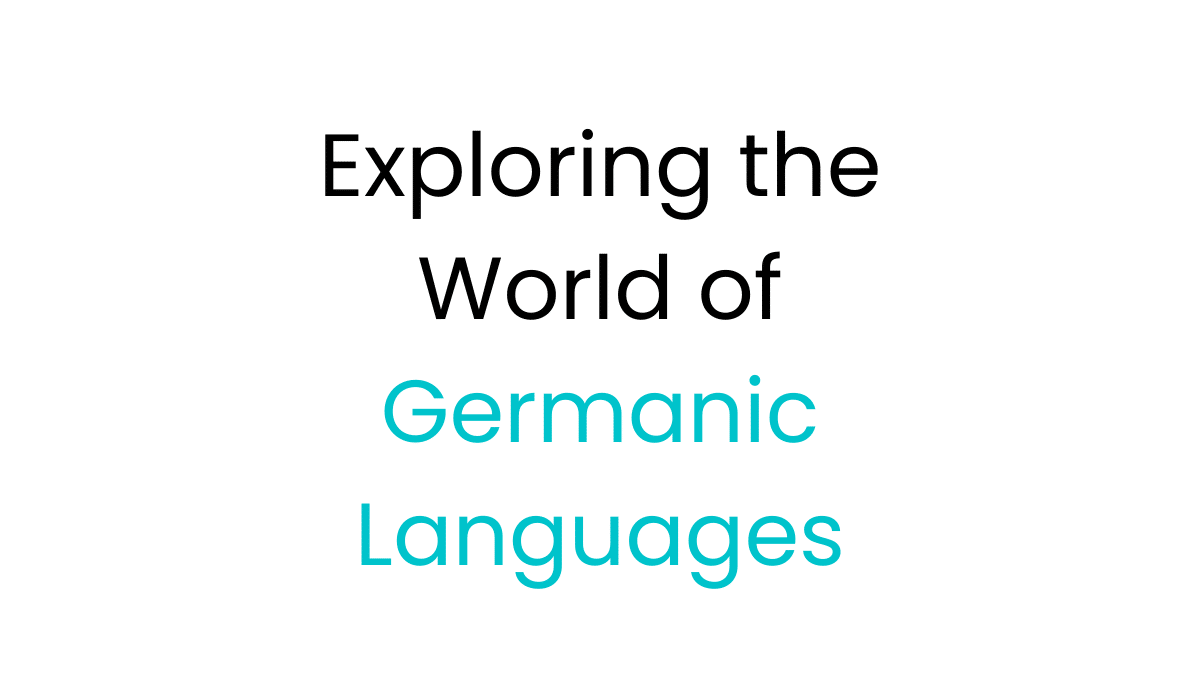Introduction
In today’s interconnected world, communication is the key to understanding and collaboration. But with countless languages spoken worldwide, how do people from diverse backgrounds effectively communicate? Enter “lingua franca,” a term that holds the key to bridging linguistic gaps and fostering global understanding. In this comprehensive article, we will delve into the concept of lingua franca, exploring its origins, significance, and contemporary relevance, shedding light on its profound impact on our global society.
- Introduction
- What is Lingua Franca?
- The Importance of a Common Language
- Lingua Franca in Modern Times
- The Cultural Impact of Lingua Franca
- Lingua Franca in Education
- The Future of Lingua Franca
- Examples Of Lingua Franca
- Lingua Franca's Role in Globalization
- The Linguistic Kaleidoscope
- The Journey of Learning a Lingua Franca
- Lingua Franca and Technology
- The Beauty of Language Diversity
- Conclusion
Key Takeaways:
- Historical Significance: Lingua franca, originally “Frankish language,” emerged in the Middle Ages, laying the foundation for today’s lingua franca.
- Common Language’s Importance: Lingua franca streamlines international trade, diplomacy, and cultural exchange, promoting peaceful relations.
- English Dominance: English serves as the global lingua franca, facilitating international communication.
- Challenges and Controversies: Lingua franca raises concerns like linguistic imperialism and cultural homogenization.
- Embracing Multilingualism: Multilingualism alongside lingua franca offers cognitive benefits and broadens perspectives.
What is Lingua Franca?
2.1 Historical Origins
Lingua franca, historically known as the “Frankish language,” had its roots in the Mediterranean during the Middle Ages. It emerged as a practical solution for merchants, sailors, and traders who needed to communicate with people from various linguistic backgrounds. This pidgin language was a fascinating blend of Italian, French, Arabic, and other languages. It was stripped down to its essentials, making it simple yet effective for basic communication. This historical lingua franca paved the way for today’s concept of a common bridge language, essential for a globalized world.
Simply put: if a group of people speaks different languages but use one to communicate, that’s their Lingua Franca; a bridge that connects them.
2.2 Lingua Franca vs. Pidgin Languages
While lingua franca shares similarities with pidgin languages, it distinguishes itself by serving as a mediator between speakers of diverse native tongues. Pidgin languages, on the other hand, typically evolve within specific communities as simplified forms of communication. Lingua franca was a tool of necessity for trade and interaction, whereas pidgin languages often develop organically as a means of intercultural communication within isolated groups. Understanding this distinction helps us appreciate the role lingua franca played in bridging linguistic gaps.
The Importance of a Common Language
3.1 Facilitating Trade and Commerce
One of the primary functions of a lingua franca is to facilitate international trade and commerce. In the historical context, it allowed traders from different regions to conduct business transactions without the need for a shared native language. This streamlined communication sped up negotiations, agreements, and economic exchanges. In the modern world, a lingua franca, often English, plays a crucial role in global business, making it possible for companies to engage with partners, clients, and customers from around the world. The efficiency it brings to international trade is undeniable.
3.2 Diplomacy and International Relations
Beyond commerce, lingua franca is equally vital in diplomacy and international relations. It ensures that diplomats, politicians, and representatives from different nations can communicate effectively during negotiations and discussions. Misunderstandings can be costly in this arena, making a lingua franca an indispensable tool for maintaining peaceful relations among countries. The ability to converse diplomatically in a shared language helps prevent conflicts and encourages the resolution of global issues through dialogue.
Lingua Franca in Modern Times
4.1 English as a Global Lingua Franca
In contemporary times, English has risen as the quintessential global lingua franca. Its dominance can be attributed to its widespread use in various domains such as business, academia, science, and the entertainment industry. This prevalence allows individuals from different linguistic backgrounds to interact seamlessly. English’s status as a lingua franca has led to its widespread adoption as a second language by millions worldwide, enabling them to participate in a globalized world where communication knows no linguistic boundaries.
4.2 Challenges and Controversies
While English’s role as a lingua franca has undeniable advantages, it is not without challenges and controversies. Critics argue that the dominance of one language can lead to linguistic imperialism, potentially sidelining lesser-known languages and cultures. There are concerns about cultural homogenization and the preservation of linguistic diversity. Additionally, debates surround the issue of language proficiency and access to opportunities in English-dominated fields. Acknowledging these challenges is essential for fostering a balanced approach to the use of English as a global lingua franca.
The Cultural Impact of Lingua Franca
5.1 Language Homogenization vs. Diversity
The impact of lingua franca on cultures is a topic of discussion. On one hand, it facilitates understanding among diverse communities, but on the other hand, there are concerns about language homogenization. As lingua franca spreads, it may influence local languages and dialects, potentially leading to their decline. Striking a balance between embracing the benefits of lingua franca and preserving linguistic diversity is a challenge that societies must navigate.
5.2 Influence on Pop Culture
Lingua franca’s influence extends to the realm of pop culture. Movies, music, literature, and digital media transcend linguistic borders, reaching global audiences. This phenomenon has created a unique fusion of cultures, where artistic expressions from different parts of the world influence and inspire one another. Pop culture has become a powerful tool for promoting cultural exchange and understanding, aided by the accessibility of lingua franca in the digital age.
Lingua Franca in Education
6.1 Advantages and Disadvantages
The adoption of a lingua franca in education offers both advantages and disadvantages. On the positive side, it enhances international cooperation and knowledge sharing. Students worldwide can access a wealth of information and connect with peers globally. However, it also presents challenges, including the need for language proficiency and the potential for inequalities in access to educational resources. Balancing these pros and cons is crucial when considering the role of a lingua franca in educational settings.
6.2 Multilingualism and Cognitive Benefits
Promoting multilingualism alongside a lingua franca can lead to cognitive benefits. Studies show that multilingual individuals often possess enhanced problem-solving skills, improved memory, and greater cultural awareness. Multilingualism fosters a broader perspective on the world, enabling individuals to engage more deeply with different cultures and ideas. Encouraging multilingualism alongside a lingua franca can contribute to more well-rounded and adaptable individuals.
The Future of Lingua Franca
7.1 Emerging Contenders
While English currently holds the position of global lingua franca, other languages are emerging as contenders. Mandarin Chinese, Spanish, and Arabic are among those gaining prominence on the international stage. These languages are becoming increasingly important for global trade, diplomacy, and cultural exchange. The emergence of new contenders suggests that the landscape of global lingua franca may evolve in the coming years, reflecting shifts in economic and political power.
7.2 Technological Advances
Advancements in technology are reshaping the landscape of lingua franca communication. Real-time translation apps, AI-driven language tools, and digital communication platforms have made it easier than ever to communicate across language barriers. These innovations are breaking down linguistic walls, making it possible for individuals and businesses to interact with people from different language backgrounds seamlessly. The integration of technology into lingua franca communication is driving global connectivity to new heights.
Examples Of Lingua Franca
8.1 Mandarin Chinese as a Lingua Franca
Mandarin Chinese, the most spoken language in the world, holds a significant place as a lingua franca in East Asia. With over a billion native speakers, it serves as a bridge for communication in countries like China, Taiwan, Singapore, and Malaysia. Its importance is also growing in global business, where China’s economic influence is expanding. Learning Mandarin has become an invaluable skill for those seeking opportunities in international trade and diplomacy within this dynamic region.
8.2 Spanish as a Lingua Franca
Spanish, one of the Romance languages, has established itself as a prominent lingua franca across the Americas and parts of Europe. Beyond its native speakers in Spain and Latin America, Spanish serves as a common language for millions of people. It facilitates communication among diverse cultures, including the United States, where it is the second most spoken language. Spanish plays a pivotal role in international relations, trade, and cultural exchange, making it a vibrant and dynamic lingua franca.
8.3 Arabic as a Lingua Franca
Arabic, with its rich history and cultural significance, serves as a lingua franca across the Arab world, extending from the Middle East to North Africa. While numerous dialects exist, Modern Standard Arabic is commonly used in formal contexts, such as education, media, and diplomacy. Arabic’s status as a lingua franca reflects the shared cultural heritage of Arabic-speaking nations and is instrumental in facilitating cooperation and understanding in this diverse region, both in business and politics.
Lingua Franca’s Role in Globalization
9.1 Business and Career Opportunities
Lingua franca’s role in business and career opportunities cannot be overstated. Proficiency in a global lingua franca, such as English, opens doors to international markets, collaborations, and career advancements. In the corporate world, it allows companies to engage with clients, partners, and customers from diverse linguistic backgrounds, fostering global expansion. For individuals, a strong command of a lingua franca can lead to diverse career paths, from diplomacy and translation services to international sales and marketing. Lingua franca is the key that unlocks a world of professional opportunities and global connectivity.
9.2 Cultural Exchange and Understanding
Beyond business, lingua franca plays a crucial role in promoting cultural exchange and understanding. It acts as a bridge between people from different cultural backgrounds, allowing them to share their traditions, beliefs, and stories. This exchange enriches the tapestry of global culture, fostering empathy and respect for diverse perspectives. Through lingua franca, individuals can explore other cultures, form cross-cultural friendships, and contribute to a more harmonious and interconnected world. Cultural exchange facilitated by lingua franca is a powerful force for building bridges and breaking down stereotypes.
The Linguistic Kaleidoscope
10.1 Preserving Endangered Languages
While embracing a lingua franca, it is paramount to recognize the importance of preserving endangered languages. Many languages face the risk of extinction, taking with them unique cultural knowledge and history. Efforts must be made to document, revitalize, and protect these endangered languages, ensuring they continue to thrive alongside the lingua franca. The coexistence of a lingua franca with linguistic diversity is a testament to our commitment to cultural heritage and the preservation of the world’s linguistic kaleidoscope.
10.2 Balancing Uniformity and Uniqueness
The delicate balance between a lingua franca’s uniformity and the preservation of linguistic uniqueness is an ongoing challenge. While a common language facilitates communication, it’s crucial to safeguard the distinctiveness of each language and culture. Finding this equilibrium requires thoughtful policies that promote multilingualism, nurture linguistic diversity, and ensure that no language is marginalized. The world benefits when linguistic diversity flourishes alongside the convenience of a lingua franca, creating a harmonious coexistence.
The Journey of Learning a Lingua Franca
11.1 Tips for Language Learners
For those embarking on the journey of learning a lingua franca, a few tips can be immensely helpful. Immerse yourself in the language and culture, whether through travel, language courses, or social interactions. Practice regularly and embrace your mistakes as learning opportunities. Utilize language learning apps, engage with native speakers, and set achievable goals to measure your progress. Learning a lingua franca is not just about words; it’s about embracing a new perspective and understanding different ways of thinking and expressing.
11.2 Overcoming Language Barriers
Breaking down language barriers is essential in a world where effective communication is the key to collaboration and understanding. To overcome these barriers, employ technology, such as translation apps, to facilitate conversations. Be patient and empathetic when communicating with non-native speakers, as they may be navigating the complexities of a new language. Language should never be a barrier to empathy, and lingua franca can help bridge the gap between people of different linguistic backgrounds.
Lingua Franca and Technology
12.1 Translation and Language Apps
In an increasingly interconnected world, the role of technology, specifically translation and language apps, is pivotal in lingua franca communication. These tools empower individuals and businesses to communicate effortlessly across language barriers. Real-time translation apps allow for seamless conversation, while language learning apps facilitate language acquisition. As technology continues to advance, these apps are becoming more accurate and user-friendly, making lingua franca communication more accessible to everyone.
12.2 AI and the Future of Communication
Artificial intelligence is poised to revolutionize communication in the lingua franca landscape. AI-driven language tools are becoming smarter, and capable of understanding context and nuances in language. This technology promises to make lingua franca communication even more efficient and accurate, expanding its reach and accessibility. As AI continues to evolve, it will play an increasingly significant role in breaking down linguistic barriers, enabling global collaboration and understanding on an unprecedented scale.
The Beauty of Language Diversity
13.1 Embracing Multilingualism
Embracing multilingualism is a celebration of linguistic diversity and cultural richness. It involves valuing not only the lingua franca but also the multitude of languages spoken around the world. Multilingualism encourages individuals to explore different linguistic landscapes, broadening their horizons and deepening their connections with others. It promotes cross-cultural understanding and opens doors to unique experiences, fostering a global society that treasures the beauty of language diversity.
13.2 A Tapestry of Expressions
Every language contributes to the tapestry of human expression, offering unique perspectives on life, emotions, and the world. Lingua franca, while essential for global communication, is just one thread in this rich tapestry. Each language adds vibrant colors and intricate patterns to our collective understanding of humanity. Recognizing the value of linguistic diversity and embracing the myriad ways languages express our shared experiences enriches our global culture and fosters a deeper appreciation of the beauty of words.

Conclusion
Lingua franca stands as a testament to our ability to bridge divides, connect cultures, and foster global understanding. It’s a tool that, when wielded with respect and sensitivity, can propel humanity towards a future where language is a bridge, not a barrier.
Continue learning with us here.
Oualid Cheddadi is the founder of Lingualid, a platform that inspires independent language learners worldwide, regardless of the language they are learning. The name “Lingualid” is derived from the Portuguese word for “language,” “língua,” and the last three letters of Oualid’s name, “Lid.”



